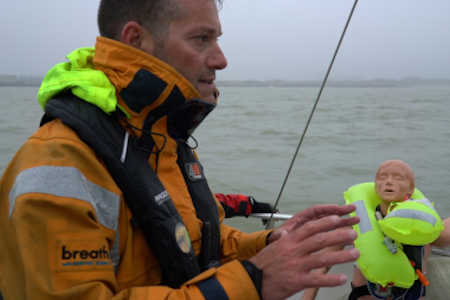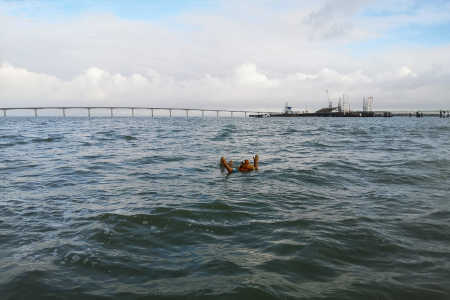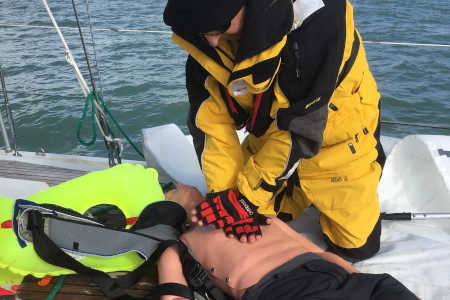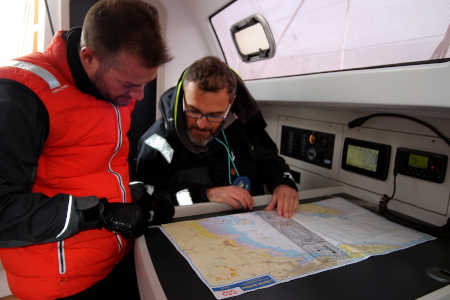In recent years, boat license training centers (training schools) have seen a surge in exam pass rates, with some boasting a 99% success rate. But what would it really be like if once again an examiner had to validate the practical navigation part…
"Since 2008, candidates no longer need the approval of a state examiner for the practical part."
Two hours of individual practice at the helm of a vessel!!! Is that enough to have a good foundation for navigation and to avoid some of the beginner's pitfalls? But judging by the success rate, all new sailors must be excellent mariners!!!
However, one thing is certain for the vast majority of them… They lack experience, and the practical training should be less condensed… 2 hours, or even 3 or 4 hours of navigation to learn how to pilot a motorized vessel are absolutely not enough to acquire the essential skills needed to control all nautical situations.
Solid foundations are essential during the learning phase, enabling sailors to gain valuable experience in future navigation. But this experience can only be gained if the sailor has enough confidence in themselves.


While staying within the legal framework of the coastal pleasure boating license training and exam, we will guide you with in-depth training to ultimately achieve better control in complex nautical situations.
Theory day where it is strongly recommended to have read your code book several times.
This 1st day of training for the coastal license in La Rochelle includes a 5-hour theoretical training program, with an additional 2 hours dedicated solely to the safety of the vessel and the crew. This module consists of risk prevention and forecasting through the management of passive and active safety. It covers all the measures to be taken to avoid the emergence or worsening of a nautical risk and teaches how to react in the event of a deteriorating situation onboard.


This boat license day in La Rochelle is entirely dedicated to maneuvers and hands-on boat practice. The program allows you to sail all day to achieve the goals for the various competencies targeted.
To know …
- Ensure individual and collective safety
Through the use of various onboard equipment such as personal flotation devices, the life buoy, and other means to save one or more lives in case of a deteriorating situation. There is mandatory safety equipment, but nothing prevents you from adding extra safety measures. The list is non-exhaustive!!!
- Know the basic rules for using onboard communication devices
You will have the opportunity to communicate via radio when managing the development of a risk, such as handling a victim or an injured person onboard… it's up to you to make the right choice, and your instructor will be there to assist you.
- Respect the buoyage system and identify obstacles in the area
It is absolutely necessary to be able to anticipate while navigating and to assess in advance the various buoyage encountered in your navigation areas.
- Be responsible for the crew and the boat
You will play the role of captain, having to make important decisions in delicate and very degraded situations.
- Use distress signals
To first signal your position by radio, but then by using a handheld pyrotechnic flare, allowing other users to see you.
- Mastering deck maneuvers and steering
Whether it’s following alignments, taking courses, performing avoidance maneuvers, or changing tack. Also, port maneuvers with or without current, with or without wind...
- Master the use of paper and electronic navigation charts
You will never get lost, and even in case of an electronic failure onboard, you will learn to master reading a paper chart from the Hydrographic and Oceanographic Service of the Navy (SHOM) for your navigation area.
- Take a mooring, perform anchoring
Moor to a buoy with a crew or solo... And because sometimes situations require it in case of engine failure, learn to mark your position and anchor. But if the wind rises even more, do you know the safety anchoring procedure? Anchoring is an integral part of safeguarding your vessel, especially when considering shelter, which allows for securing the boat and its occupants.
- Recover a man overboard
The man overboard procedure or the art of recovering a crew member who has fallen overboard… You will work on this second day with an aquatic rescue mannequin that weighs 80kg once wet (filled with water)!!! Learn to adopt the correct method… and what if the man overboard is you!!! We will certainly cover lifesaving actions in this situation… especially if your man overboard is no longer breathing!!!
This 3rd and final day is focused on "real-life damages" in 100% practical training.
- You will recover real people from the sea,
Depending on the situation, you will need to take the best option, and once your victim is onboard, you will need to contact the CROSS or CCMM to receive guidance after completing a medical assessment. Your person (man, woman, or child) who fell into the water could quickly lose consciousness if you lose visual contact! But have you considered how to bring them back aboard your vessel? Could a boathook be enough? It is often easier to return to the person overboard, but more complicated to bring them back on board...
- You will have a steering failure,
You will need to know where the emergency tiller is and how to use it… And what if there is no emergency tiller aboard?
- You will have a water ingress,
What is the first reflex to have in case of water ingress? You will use the VHF radio to report your incident and receive guidance on how to handle it, especially if your vessel starts sinking.
- You will have a fire on board,
One of the fire detectors will start ringing, smoke will fill the cabin, a very oppressive situation that could make you lose your bearings, especially if one of your crew members is having difficulty breathing due to inhaling toxic smoke. Do you know how long it will take for your vessel’s contents to burn completely? Remember, in the first minute, using a fire extinguisher is crucial to saving the crew and protecting your vessel.
- You will evacuate your vessel,
You will have to evacuate your vessel because you are certain it will sink… You will experience the role of a shipwrecked person for long minutes. If you have a liferaft, it’s time to launch it from the right side of your vessel and board it once the distress signal has been sent via VHF radio in DSC or voice on channel 16.
This "Boat License SAFETY training in La Rochelle" helps you better appreciate the coastal boating license training. It is a very comprehensive course that covers all major topics and associated nautical risks. It will certainly make you feel much more confident in case of difficulties on board. You will know "why" you carry safety equipment, but more importantly, how to use it.
Remember, at sea, you won't have help in 15 minutes like you would on land, and sometimes you’ll need to rely on good seamanship and calm... and also have some basic first aid knowledge with lifesaving techniques.
In recent years, boat license training centers (training schools) have seen a surge in exam pass rates, with some boasting a 99% success rate. But what would it really be like if once again an examiner had to validate the practical navigation part…
"Since 2008, candidates no longer need the approval of a state examiner for the practical part."
Two hours of individual practice at the helm of a vessel!!! Is that enough to have a good foundation for navigation and to avoid some of the beginner's pitfalls? But judging by the success rate, all new sailors must be excellent mariners!!!
However, one thing is certain for the vast majority of them… They lack experience, and the practical training should be less condensed… 2 hours, or even 3 or 4 hours of navigation to learn how to pilot a motorized vessel are absolutely not enough to acquire the essential skills needed to control all nautical situations.
Solid foundations are essential during the learning phase, enabling sailors to gain valuable experience in future navigation. But this experience can only be gained if the sailor has enough confidence in themselves.


While staying within the legal framework of the coastal pleasure boating license training and exam, we will guide you with in-depth training to ultimately achieve better control in complex nautical situations.
Theory day where it is strongly recommended to have read your code book several times.
This 1st day of training for the coastal license in La Rochelle includes a 5-hour theoretical training program, with an additional 2 hours dedicated solely to the safety of the vessel and the crew. This module consists of risk prevention and forecasting through the management of passive and active safety. It covers all the measures to be taken to avoid the emergence or worsening of a nautical risk and teaches how to react in the event of a deteriorating situation onboard.


This boat license day in La Rochelle is entirely dedicated to maneuvers and hands-on boat practice. The program allows you to sail all day to achieve the goals for the various competencies targeted.
To know …
- Ensure individual and collective safety
Through the use of various onboard equipment such as personal flotation devices, the life buoy, and other means to save one or more lives in case of a deteriorating situation. There is mandatory safety equipment, but nothing prevents you from adding extra safety measures. The list is non-exhaustive!!!
- Know the basic rules for using onboard communication devices
You will have the opportunity to communicate via radio when managing the development of a risk, such as handling a victim or an injured person onboard… it's up to you to make the right choice, and your instructor will be there to assist you.
- Respect the buoyage system and identify obstacles in the area
It is absolutely necessary to be able to anticipate while navigating and to assess in advance the various buoyage encountered in your navigation areas.
- Be responsible for the crew and the boat
You will play the role of captain, having to make important decisions in delicate and very degraded situations.
- Use distress signals
To first signal your position by radio, but then by using a handheld pyrotechnic flare, allowing other users to see you.
- Mastering deck maneuvers and steering
Whether it’s following alignments, taking courses, performing avoidance maneuvers, or changing tack. Also, port maneuvers with or without current, with or without wind...
- Master the use of paper and electronic navigation charts
You will never get lost, and even in case of an electronic failure onboard, you will learn to master reading a paper chart from the Hydrographic and Oceanographic Service of the Navy (SHOM) for your navigation area.
- Take a mooring, perform anchoring
Moor to a buoy with a crew or solo... And because sometimes situations require it in case of engine failure, learn to mark your position and anchor. But if the wind rises even more, do you know the safety anchoring procedure? Anchoring is an integral part of safeguarding your vessel, especially when considering shelter, which allows for securing the boat and its occupants.
- Recover a man overboard
The man overboard procedure or the art of recovering a crew member who has fallen overboard… You will work on this second day with an aquatic rescue mannequin that weighs 80kg once wet (filled with water)!!! Learn to adopt the correct method… and what if the man overboard is you!!! We will certainly cover lifesaving actions in this situation… especially if your man overboard is no longer breathing!!!
This 3rd and final day is focused on "real-life damages" in 100% practical training.
- You will recover real people from the sea,
Depending on the situation, you will need to take the best option, and once your victim is onboard, you will need to contact the CROSS or CCMM to receive guidance after completing a medical assessment. Your person (man, woman, or child) who fell into the water could quickly lose consciousness if you lose visual contact! But have you considered how to bring them back aboard your vessel? Could a boathook be enough? It is often easier to return to the person overboard, but more complicated to bring them back on board...
- You will have a steering failure,
You will need to know where the emergency tiller is and how to use it… And what if there is no emergency tiller aboard?
- You will have a water ingress,
What is the first reflex to have in case of water ingress? You will use the VHF radio to report your incident and receive guidance on how to handle it, especially if your vessel starts sinking.
- You will have a fire on board,
One of the fire detectors will start ringing, smoke will fill the cabin, a very oppressive situation that could make you lose your bearings, especially if one of your crew members is having difficulty breathing due to inhaling toxic smoke. Do you know how long it will take for your vessel’s contents to burn completely? Remember, in the first minute, using a fire extinguisher is crucial to saving the crew and protecting your vessel.
- You will evacuate your vessel,
You will have to evacuate your vessel because you are certain it will sink… You will experience the role of a shipwrecked person for long minutes. If you have a liferaft, it’s time to launch it from the right side of your vessel and board it once the distress signal has been sent via VHF radio in DSC or voice on channel 16.
This "Boat License SAFETY training in La Rochelle" helps you better appreciate the coastal boating license training. It is a very comprehensive course that covers all major topics and associated nautical risks. It will certainly make you feel much more confident in case of difficulties on board. You will know "why" you carry safety equipment, but more importantly, how to use it.
Remember, at sea, you won't have help in 15 minutes like you would on land, and sometimes you’ll need to rely on good seamanship and calm... and also have some basic first aid knowledge with lifesaving techniques.